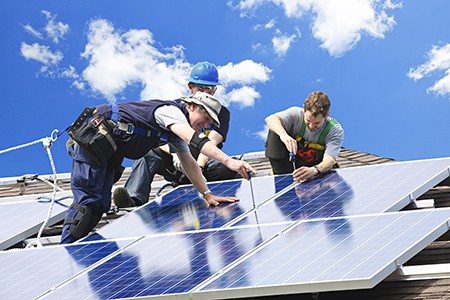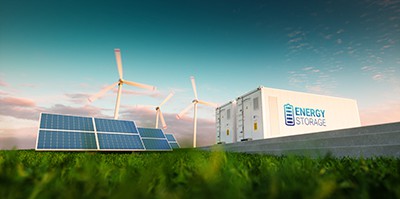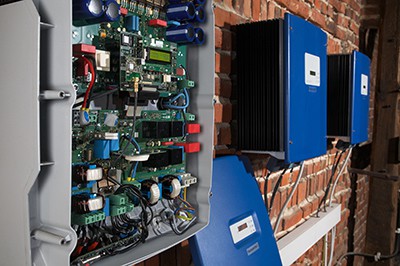What is a Solar Generator?

A solar energy generator is an alternative power source that uses renewable energy from the sun to produce voltage. Many solar power generation devices can fall into this category, including farm solar panels, a smart solar box, and a power station system. Some solar power output devices come equipped with a graphical user interface for increased usability.
Solar generators are used to supply power to other machines or power grids. A solar energy harnessing device cannot stand on its own in most cases because it can’t collect and supply power instantaneously. A battery or another energy source must work in combination with a solar energy harnessing device.
Here’s what you should know before buying a solar powered generator for home use.
What Components make up a Solar Generator?
Solar power devices usually contain solar panels, a solar battery charger, solar batteries, and a charge inverter.

The solar panel is responsible for direct energy conversion, and this energy is processed through battery storage. Energy from the battery charger is used to fuel several batteries. A charge inverter converts stored energy in each battery bank to AC power for the device.
More advanced solar power devices may contain a circuit breaker, which prevents them from drawing too much electricity. A DC portable power supply is often used as a backup energy source. Depending on which solar module you use, you can also set up solar array mounting racks, or a solar battery charger to provide it with more power. A free-standing rack grid can be mounted on rooftops and require little maintenance.
How does a Solar Energy Generator Work?
A solar energy generator integrates a battery pack, charge controller, and an inverter into a compact system to turn solar energy into an electrical current. Each component is designed to match the electricity rating of the device that is receiving power. Standard voltage ratings for solar generators are 12, 24, and 48 volts.

The battery acts as an intermittent energy source that can be saved for later use. A lithium ion battery is the most commonly used for its long lifespan and affordability. Most solar devices will run on a lithium battery. A lead acid battery is another common choice.
The charge controller is responsible for regulations of the electrical current to protect against electrical damage. This ensures that there is not too much current sent to the batteries. A battery rating indicates how much current the batteries can tolerate.
Most electrical devices use AC, so the inverter converts direct current (DC) into alternating current. Items that use DC do not require the inverter. The inverter steps up the generator voltage rating from 12, 24, or 48 volts to the small appliance voltage rating of 110 or 240 volts. With the help of an inverter, solar generators can work with a variety of permanent or portable solar panels.
How much Energy can a Solar Energy Generator Supply?
The amount of energy provided depends on each device. Generally, solar generators sell at a storage capacity between 0.1 and 2 kWh. Therefore, a single solar power generator should not be expected to power large-scale systems.
Which Devices Can a Solar Energy Generator Power?
A solar energy generator is ideal for any small device, such as home appliances, portable electronics, and some industrial tools. Solar power can charge smartphones, tablets, and portable GPS technology several hundred times. A refrigerator can run on a single generator for a few dozen hours. More powerful equipment such as construction devices or a solar pool heater can only operate at low power through a solar power generator.
What Are the Best Solar Generators?
Most well-reviewed solar generators share the same key qualities. Some of these qualities revolve around affordability. Others focus on efficiency.

The first quality is device complexity. Sophisticated technology is needed to drive high-quality generators, but generators should also be easy to assemble. Manufacturers should provide a detailed manual of device assembly. A specification of each component should be included as well.
Lighter generators are easier to carry around. The tradeoff is that they store less energy. It is best to carry a DC portable power supply.
Inverter rating is another key quality. A higher alternator wattage rating is not always ideal. All appliances have a maximum electrical threshold. An inverter can step up the generator rated voltage to the correct appliance voltage.
On the other hand, a highly-rated battery capacity is ideal. A good quality battery prevents excessive charge from damaging the generator. Both the battery life and generator storage device can last longer.
What are the Different Types of Solar Generators?
Solar backup generators are more practical for large-scale devices such as a television, refrigerator, or indoor lighting. Combinations of backup generators may be used with farm solar panels or near a power station system. These generators have the highest alternator wattage rating. Most solar backup generators are designed to be used in an emergency during a power outage.
The main disadvantage of solar backup generators is that they are very heavy and can be difficult to move around. They also tend to be the most expensive type of generator. Most generators do not provide the same amount of fuel as an electrical energy generator regarding their price. However, they are more environmentally friendly than electrical energy generators.

A portable solar generator is the most lightweight and possibly the most versatile type of solar generator. The batteries are rated lower compared to their backup counterparts. Therefore, they are best suited for small appliances such as laptops, cameras, and cordless tools. A portable solar generator may come with a strap like a suitcase, making it easier to carry around.
One disadvantage to portable generators is that they are not well-suited for larger appliances such as washing machines or refrigerators. They may power larger appliances for a few hours at the most. Portable generators also need to be recharged more frequently for anyone who regularly uses generators.
Regardless, their pros outweigh their cons. Portable generators are an affordable investment and can be used in many situations. Their compact technology makes them easy to take on the road as well.
A smart solar box is an automated generator that regulates energy according to its condition. These devices can save time on manual calibration. A smart solar box can be designed from various components, including a car battery as a simple exterior to hold the battery. Many smart solar boxes use a 50-watt solar panel.
How to Design a DIY Generator
Anyone can build a solar generator using a DIY solar generator kit. These kits are produced by a solar generator manufacturer and are commonly used in DIY solar panel projects. Some DIY solar generators come with all the necessary components to build the generator right away. Other kits may have parts that need to be ordered separately. When getting parts separately, make sure that they are in good condition and fit together well (for example, double-check which solar charger and power inverter are compatible with your generator, as both are vital for conducting electricity).
There is more responsibility involved when it comes to a DIY generator project. A consumer should ensure that all devices are compatible with each other. It is also to note the rating of home appliances or systems. It also helps to have some experience with assembling electronic components. There are many available kits to fit different needs.
Some devices are more environmentally friendly, while others may prioritize conversion efficiency. Most manufacturers have a specification sheet available before purchase.
Do your homework when researching solar generators and find what type of generator you’d like to build. For example, if you’d like a DIY portable solar generator, determine specifications such as battery capacity, portable solar panel construction, and whether it will have enough power to replace fossil fuel power on the go.
Consider how often you’ll need to use the generator and the attached solar array. How much do you plan to use your solar powered generator? If it’s a primary power source, how much do you need to warm and light your home? Perhaps your home only needs occasional backup power from its solar input, but if you’re replacing a fossil fuel generator, be prepared to know how much power it will take. You’ll also need to be familiar with electrical devices and learn the wattage and installation instructions. A solar generator kit is a great place to start because it only requires a few simple steps to construct.
What are Other Ideas for “My Solar Power Generator”
It’s good practice to test the rating of the batteries using a test alternator device. A test alternator is a device like an ammeter, which checks the voltage of a system. This practice can help to gauge the “health” of the generator.
